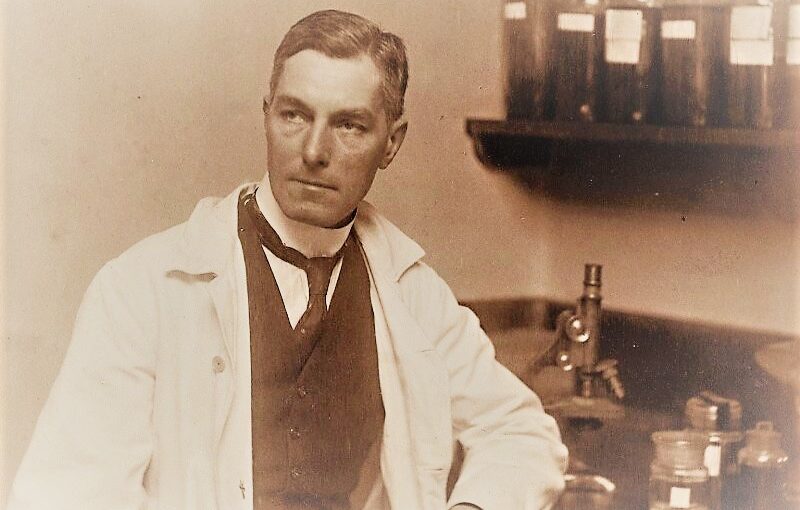Sir Bernard Henry Spilsbury was the most distinguished medical detective in England and a Freemason, like some of his colleagues and the criminals he helped bring to jail. Only the imaginary character of Sherlock Holmes exceeds him in popularity.
Spilsbury was responsible, with Scotland Yard, for the introduction of the “Murder Bag” following the “Crumbles murder” case in 1924. Patrick Mahon had killed Emily Kaye, his lover, and then dismembered her body and when Spilsbury arrived on the murder scene, he was surprised to find investigators picking up body parts with their bare hands. As a result, he devised a kit consisting of a collection of instruments – tweezers, evidence bags, and other items -which forensic detectives presently still use.
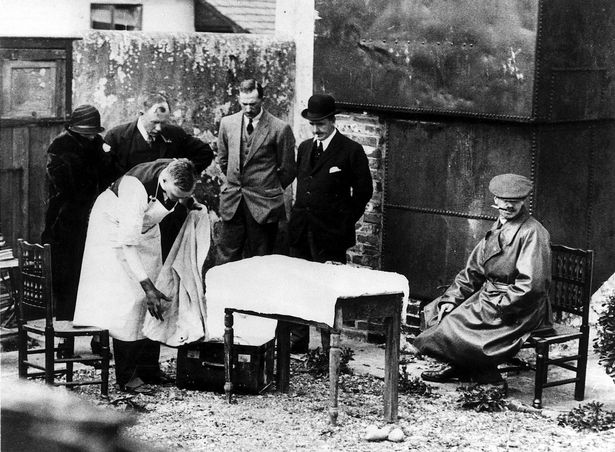
Spilsbury was also responsible for establishing the character of the “legal expert” by integrating pathology and cause-of-death examinations into the legal criminal context.
— *** —
Bernard Henry Spilsbury was born on January 16, 1877, in Leamington Spa, Warwickshire, England and was one of four offspring from the union between Marion Elizabeth Joy and James Spilsbury, a chemist. Bernard adopted his father’s passion for science but – according to the crime author Michael J Buchanan-Dunne – he also absorbed his coldness, arrogance and lack of empathy. After receiving home education, at the age of nine Bernard was sent to boarding school for three years and at the age of 15, with his parents living in Crouch End in London, he went to study chemistry, physics and biology at the Owen’s College in Manchester.
In 1895 Bernard Spilsbury enrolled at the Magdalen College, Oxford and earned his BA in natural science in 1899. He subsequently attended St. Mary’s Hospital Medical School in Paddington’s Praed Street, London, where he meant to qualify as a general practitioner. Instead, he went on to study pathology and never repented.
In 1906, Spilsbury married Edith Caroline Mary Thornton, the daughter of a dentist and had four children. The couple lived at Hindes Road in Harrow-on-the-Hill, Middlesex, until they could afford a bigger house at 31 Marlborough Hill, St John’s Wood, London which became their home from 1912 to 1940.
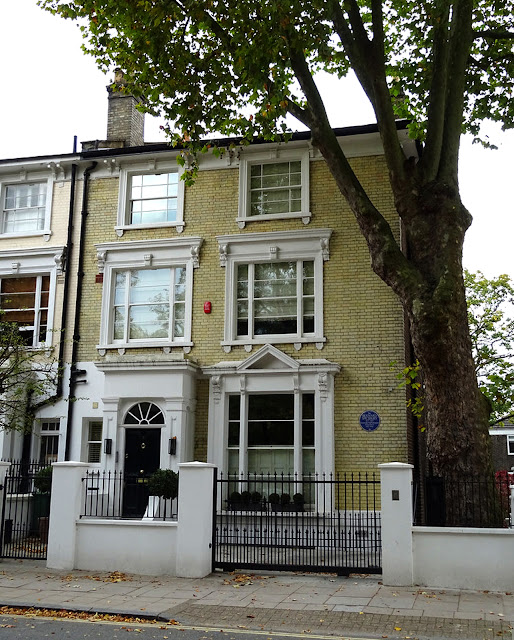
On September 3, 1908, Spilsbury took over as Chief Pathologist at St Mary’s Hospital from his mentor, Dr A. J. Pepper who, alongside the toxicologists, Dr. A. P. Luff and William Wilcox, Dr A.J. Pepper was one of the founding fathers of the new science.
Forensic medicine was in its inception at the time, and so it faced suspicion and even scorn by the medical and legal communities. To counter this, Spilsbury enumerated some guidelines for his profession in a remarkable speech given at the London Medical Society, which no doubt earned him some enemies. The British Medical Journal in his Obituary of December 1947, claimed that in the discourse Spilsbury had bravely cautioned all doctors who stepped into the witness box from using : “superlatives, exaggeration, prolixity, indistinctness, jargon, bias, loss of temper”.
New components of murder investigations, such as criminal psychology, did not escape Spilsbury’s consideration. He liked to delve into the killers’s logic, especially in how they dealt with the burden of silence, drive, power, ego and a selfishness to destroy other people’s lives. He suggested that murderers are arrogant individuals who feel unwittingly compelled to eventually confess their crime by exposing themselves and thus secure recognition. Spilsbury had observed how, in the Seddon case, the murderer had eagerly positioned himself at the police-court window, where the press photographer happened to snap his picture !
SALSBURY’S MOST FAMOUS CASES
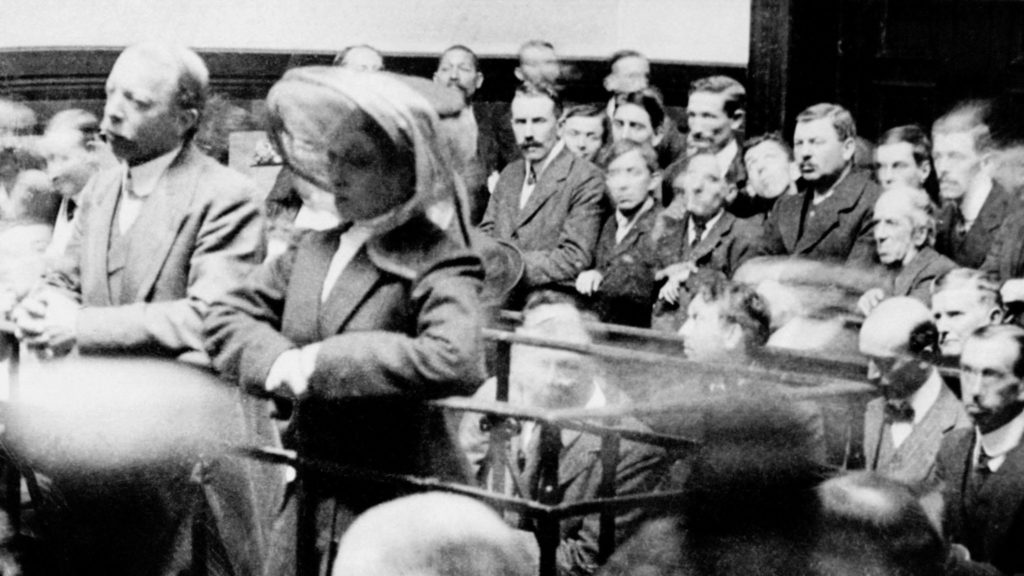
In 1910 Spilsbury was requested to testify at Dr Hawley Crippen‘s case, one of the most famous murder after the macabre and still unsolved Whitechapel killings by Jack the Ripper, nearly 30 years earlier. The role of Spilsbury in proving Crippen’s guilt through forensic medicine evidence and analysis, sealed his reputation as a police pathologist in England.
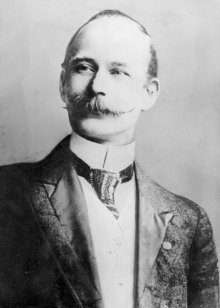
Frederick Henry Seddon, a Freemason, had been convicted of murdering Miss Barrow, his lodger, and was executed at the Pentonville Prison on 18 April 1912. It was a well-notorious case which Spilsbury had also contributed to solve.
When the Court Clerk inquired if he had anything to say, Seddon spoke for a long time and appealed for the judge to overturn the jury’s decision in the name of ‘The Great Architect Of The Universe.’ According to some accounts, he gave the third degree sign of “grief and despair” while appealing for forgiveness.
Judge Bucknill, a prominent Freemason, is quoted as saying with some emotion:
“From what you have said, you and I know we belong to one Brotherhood, and it is all the more painful for me to have to say what I am saying. But our Brotherhood does not encourage crime; on the contrary, it condemns it. I pray to you again to make your peace with the Great Architect of the Universe.“
He then pronounced the sentence of death by hanging.
In the “Major Armstrong poisoning case,” of 1922 as many as eleven of the characters involved were members of the Craft and the trial is remember as one the longest murder trials in England. Major Herbert Armstrong was a Past Master of The Loyal Hay Lodge No. 2382 in Herefordshire, and had been charged with poisoning his Law Practice rival solicitor Oswald Martin in 1921. It is peculiar to remark that Armstrong would have possibly got away with the murder of his wife, if he hadn’t sought to poison Martin. When the allegations were made by the latter, Katherine Armstrong’s body was exhumed, and tests disclosed residues of arsenic in her. Dr. Hincks, who had treated Mrs. Armstrong during her last illness,was a Freemason and so were Dr. Wilcox and Dr. Webster, the other pathologists who testified in the trial. In order to produce the poison at home, Armstrong had been acquiring increasing amounts of arsenic from his father-in-law, F. Davies, also a member of the Loyal Hay Lodge N. 2382 and the local pharmacologist. The primary court hearing was presided over by Judge Darling, who was not a Freemason, but John Hurd, the witness at the Assize trial, Tunnard Moore, chairman of the Bench at the magistrate’s court hearing, as well as William Rees, the foreman of the jury, all belonged to Loyal Hay Lodge N. 2382.
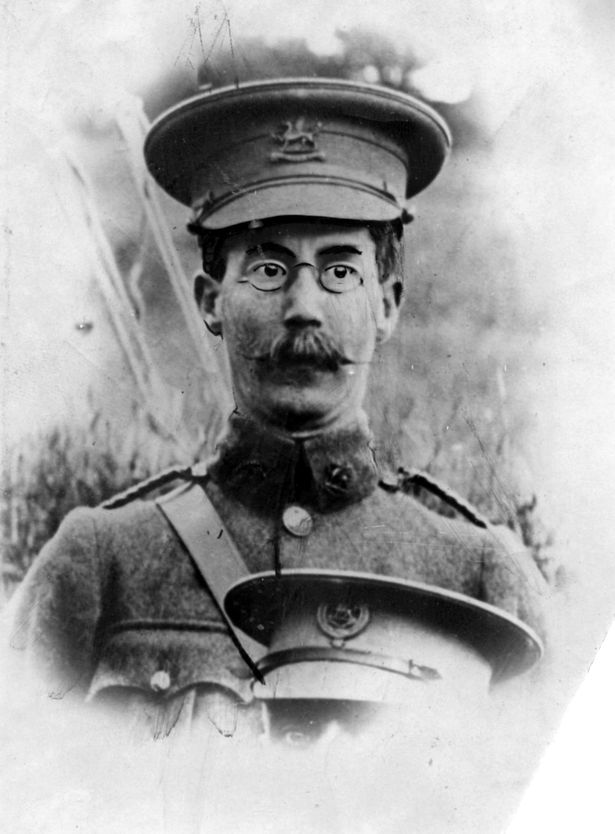
After serving as Master of the Loyal Hay N. 2382 in 1912 and Chaplain in 1920, Armstrong had been appointed Past Provincial Senior Grand Deacon for the Province of Herefordshire in 1921. It was, by any measure, a successful Masonic career but none of that, however, shielded him from passionate instincts capitulation and from carrying out an abominable crime.
This evinces the fact that Freemasonry must always be very selective in whom it admits and decisive in weeding out rogues from its rank, regardless of their status. The rotting fruit in the barrel can have terrible consequences for everyone.
SPILSBURY’S MASONIC CAREER
Spilsbury gave talks and presentations at St Mary’s Hospital, while also aiding the coroner and the police. One day he got into an argument with one of his coworkers and the case went to the Court of Governors. Spilsbury was not found to be at fault, but he had already determined to quit and resigned in 1920. He was enthusiastically welcomed as a lecturer on “morbid anatomy and histology” at St. Bartholomew’s Hospital, London, where he received the opportunity to join the Craft.
On 15 June 1920, at the age of forty-four, Spilsbury was initiated into Rahere Lodge No. 2546, and on 10 May 1921 he became a Master Mason. A year later, on 8 March 1922, he was exalted into Rahere a Royal Arch Chapter and on 3 May 1923 he joined the Mark Mason Lodge Abernethy No. 722. Invested with a Knighthood in the same year, Spilsbury progressed through the various offices of his Craft Lodge to become Lodge Master in 1932. In November 1933, he served as Lodge Master of his Mark Mason Lodge and was appointed in 1935 to Grand Ranks as Past Junior Grand Deacon. Following his progression to First Principal in his Chapter in 1937, he held the office of Past Assistant Grand Sodjourner , in 1939.
AFTER DEATH REPUTATION
At the height of his career between 1910 and 1930, Spilsbury was performing up to three post mortem a day, which earned him quite a bit of money, as he was being paid per autopsy. Although he was a private fellow, he was not a reclusive and enjoyed the company of a group of amateur criminologists and writers from the “Crimes Club” which enlisted as members: Sir Conan Doyle, Agatha Christie and PG Woodhouse.
Spilsbury was an impressive 6 feet 2 inches tall, wore a top hat, spats and striped trousers, all of which created an image that made him the darling of the Media. His peers described him as both smart and also “very obstinate” and according to the prestigious Law Journal, Court juries were rapidly investing Spilsbury with an aura of ‘papal infallibility”. This arouse jealousy amongst his colleagues and one defense counsel spitefully called him Saint Bernard. Concerns about Spilsbury’s considerable influence in Court and the integrity of his procedures, first arose after the Norman Thome’s murder conviction in 1925, but a number of other verdicts that were reached on the basis of Spilsbury’s work are still being disputed today.
Spilsbury’s testimonies came out as arrogant at times, and those in his profession began suggesting that his “virtuous” performances in the morgue and the courtrooms undermined the credibility of forensic pathology. It is not to be excluded that in some court cases, particularly toward the end of his life, Spilsbury may have made mistakes in his autopsies and “made it up” in Court “as he went along” with his testimony.
HIS LIFE AND DEATH
Spilsbury’s life was marred by depression and tragedy, despite his professional success.
By the outbreak of WW2, his marriage had collapsed and the house in St John’s Wood stood vacant. Edith had gone to live with her family in Solihull, Midlands, whilst Spilsbury rented lodgings in Verulam Buildings’, Grey’s Inn, Holborn.
Spilsbury’s back pain had made him addicted to painkillers all his life and in 1940, he suffered the first of two strokes. In September of the same year, his son Peter, a surgeon at St Thomas’s Hospital in Lambeth, South London, died during the Blitz. Peter was a member of the Oxford’s Apollo University Lodge N. 357 and also of St Mary Magdalene Lodge N.1523, into which his father was installed as Master in May 1941. St Mary Magdalene had been founded in London by former students of the Magdalene College in Oxford, which both father and son had attended.
After a rocket had struck Holborn in 1941, Spilsbury transferred to the Langorf Hotel, Frognal, off Finchley Road, and commuted by car to his lab at the University College Hospital, Gower Street, London.
His other son, Alan, who assisted him there, perished of tuberculosis in 1945, the same year that Spilsbury suffered a second stroke. These losses drastically changed Spilsbury’s character and his mental sharpness declined significantly. A regular smoker of up to 50 cigarettes a day, he became exhausted and troubled by the endless pressures of his distasteful work and recent financial pressures.
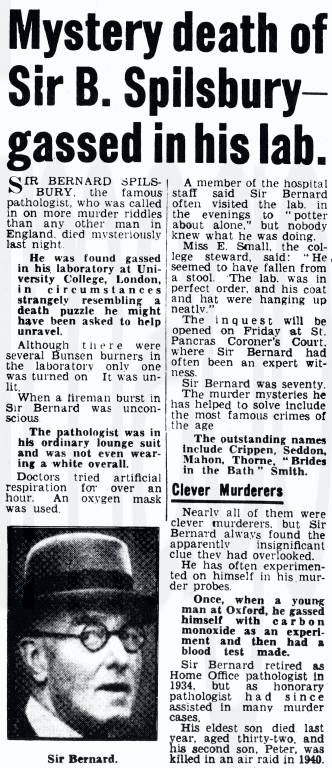
On December 17, 1947, a technician discovered him dead in his lab with the tap of a gas burner fully turned on. His close friend, the coroner Bentley Purchase, was in charge of the inquest and returned a verdict of suicide. But the circumstances of Spilsbury’s death were highly unusual; why would a man of such intellect and scientific knowledge chose to gas himself unconcerned of the probability that, had someone entered the lab with a burning cigarette in his hand , the entire building might have blown up ? Without a question, Spilsburys should have been persuaded into retirement years earlier.
He died with not many people mourning his passing, for on the 27th of December 1947, he was cremated at Golders Green, with only twenty-two people in attendance. Yet, Spilsbury is described as leaving behind a legacy as a staunch supporter of truth and justice, as a Brother of rare Masonic qualities, and as a world-eminent forensic doctor.
SOURCES
Dr Robert N Moles – netk.net.au/Books/Spilsbury1.asp
The British Medical Journal – Dec 27,1947
“Crime and The Craft” by W.Bro. Mike Neville
Freemasonry Matters – 17 July 2015
Masonrytoday.com
Kilburnwesthampstead.blogspot.com – 2nd September 2021
Murdermiletours.com – by Michael Buchanan-Dunne
- MUSIC AND THE CRAFT – LUIGI BORGHI , A FREEMASON OF THE NINE MUSES LODGE - October 31, 2022
- SPILSBURY – THE FREEMASON FATHER OF FORENSIC SCIENCE - April 18, 2022
- THE MASONIC GLOVES - March 21, 2022

